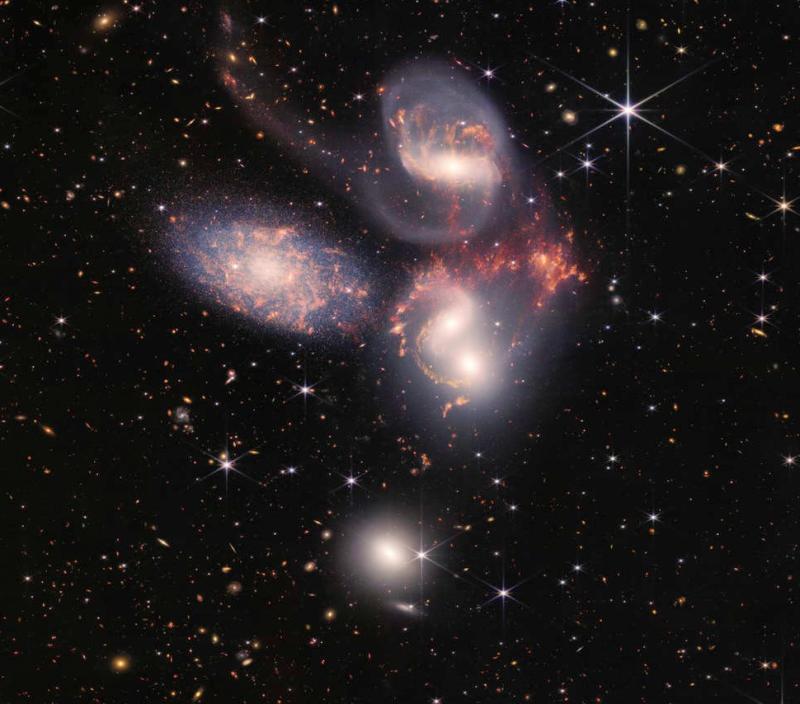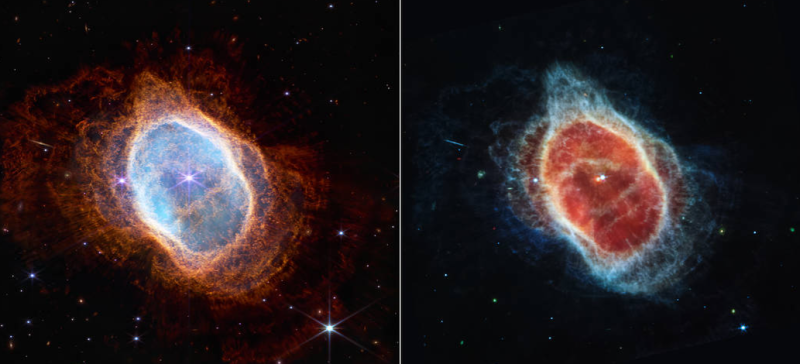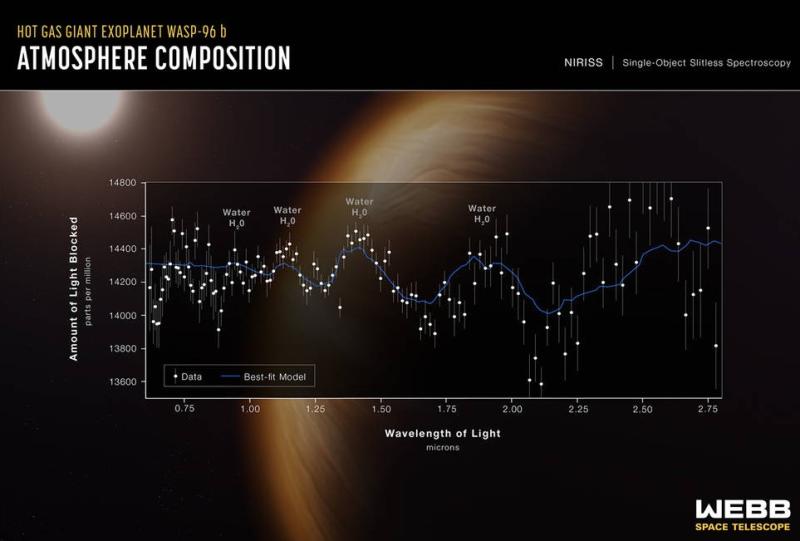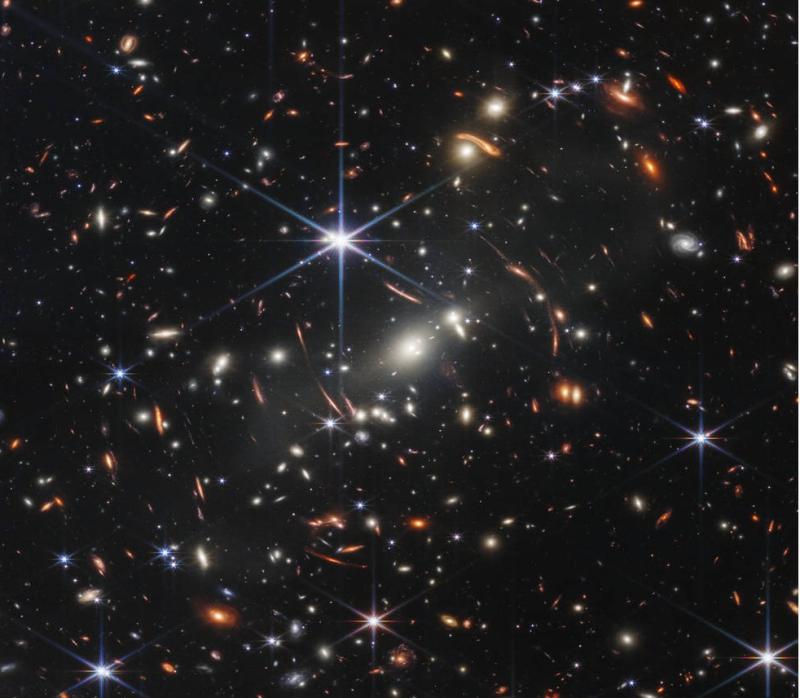NASA’s James Webb Space Telescope has just begun showing off its gifts to the world. The first full-color images were released July 12, marking the official start of Webb’s science work. The $10 billion telescope, in design and preparation for nearly 25 years, is a partnership with NASA, European Space Agency and Canadian Space Agency.
Carina Nebula (shown atop this story)
Called the Cosmic Cliffs, the picture seems almost 3D with craggy mountains seen in moonlight, to paraphrase words from NASA.
What is shown is the edge of a giant gaseous cavity within a relatively young star-forming region called NGC 3324 in the Carina Nebula. The tallest ‘peaks’ in the image are seven light years high, while the cavernous area was carved from the nebula by intense ultraviolet radiation and stellar winds from from massive, hot, young stars in the center of the bubble above the image.
Why it matters: Among other things, this image reveals for the first time areas of star birth that were previously invisible.

Stephans Quintet
This group of five galaxies is formally known as Hickson Compact Group 92.
Four of the galaxies are close together, interacting in various ways, while the one on the left is much closer to Webb, about 40 million light years away. The others are about 290 million light years away. (Not that far, really, considering some galaxies are more than 13 billion light years away.) Webb was able to pick out individual stars in the one on the left, NGC 7320.
The top galaxy in the group is called NGC 7319 and contains a supermassive black hole that is actively pulling in material while putting out light energy equal to 40 billion suns in our galaxy.
Stephan’s Quintet was first discovered by French astronomer Edouard Stephan in 1877 and was featured in the holiday film, “It’s a Wonderful Life.”
Why it matters: Scientists hope to learn from this image and others how galactic interactions and even collisions may have been the driver for galaxy evolution and movement in the early period of the universe. Study of the black hole with a Near-Infrared Spectrograph and Mid-Infrared Instrument allowed scientists to slice up the data for multiple images, piercing through dust around the nucleus to reveal hot gas near the black hole and measure the velocity of outflows in detail as never seen before.

Southern Ring Nebula
The two images are of the same planetary nebula known as NGC 3132, also known as the Southern Ring Nebula.
The image on the left was taken by Webb’s Near-Infrared Camera while the one on the right was taken by Webb’s Mid-Infrared Instrument, showing for the first time a second star surrounded by dust. The brighter star is at an earlier stage of evolution.
The two stars orbit each other and stir up gas and dust.
Why it matters: Astronomers are able to observe nebulae to view the shells around the stars and precisely measure the gas within. As stars eject shells of material and the molecules inside, the dust may travel through space for billions of years, eventually even joining a new star or planet.

WASP-96 b
The Hubble Space Telescope was able to detect water in the atmospheres of exoplanets back in 2013, but Webb can make more detailed observations that NASA called a “giant leap forward in the quest” to find potentially habitable planets beyond Earth.
In this image behind the chart, Webb picked up distinct evidence of water, clouds and haze in the atmosphere surrounding a hot, puffy gas giant planet, WASP-96 b, orbiting a distant sun-like star. Specific gas molecules were detected based on small decreases in the brightness of certain colors of light.
WASP-96 b is about 1,150 light years from Earth and is in our Milky Way galaxy. Scientists said its temperature is greater than 1000 degrees F. It can make one circuit around its sun in 3.5 days.
Why it matters: The light spectrum of WASP-96 b captured by Webb was the most detailed near-infrared transmission spectrum of an exoplanet atmosphere captured so far. Researchers use the spectrum to measure the amount of water vapor in the atmosphere and estimate the temperature of the atmosphere. They can use the information to make inferences about the make-up of the planet and how it was formed.
The blue line in the graph shows known properties of WASP-96 b and its star and assumed properties of the atmosphere. The 270 square foot gold-coated Webb mirror makes these measurements possible. A Near-Infrared Imager and Slitless Spectrograph can detect color differences of one thousandth of a micron.

SMACS 0723
SMACS 0723 is a galaxy cluster seen first by President Joe Biden on July 11. It is the deepest and sharpest infrared image of the distant universe, revealing thousands of galaxies in just a tiny sliver of space.
The deep field image is a composite of images taken at different wavelengths over 12.5 hours. The galaxy cluster is shown as it appeared 4.6 billion years ago. Light from these galaxies took billions of years to reach us.
At some points in view, the image looks back to within a billion years after the big bang, which occurred about 13.8 billion years ago.
Why it matters: With so much information available, scientists will be able to assess theories about the evolution of the universe in addition to the makeup of stars and planets and so much more. Some surprises will be in store, including a discovery that SMACS 0723 contains two similar-looking galaxies that both have bright central regions. Questions remain if they are the same, but they could be one galaxy mirrored in a second location.
It keeps getting better and better…
NASA has a treasure trove of online images and explanations that provided the basis for this story and many others yet to be told.
Image credits: NASA, ESA, CSA and STSci
RELATED: Early Webb images show supermassive black hole in Stephan’s Quintet